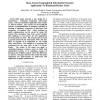Free Online Productivity Tools
i2Speak
i2Symbol
i2OCR
iTex2Img
iWeb2Print
iWeb2Shot
i2Type
iPdf2Split
iPdf2Merge
i2Bopomofo
i2Arabic
i2Style
i2Image
i2PDF
iLatex2Rtf
Sci2ools
ECIS
2000
2000
Intra-Censal Geographical Information Systems: Application to Binational Border Cities
This paper presents a new design for a census-based binational geographic information system. GIS has had limited application intra-censally i.e. between nations. The reasons are the formidable obstacles of standardization of attributes, matching of meaning of attributes, consistency of data-bases, and consistency of boundary files. Many problems in public administration can be solved by using GIS systems that encompass data from several nations. This challenge is even greater for GIS applications involving small area data. The present paper presents a general framework for dual-nation GIS's and then offers an example of its application to the United States and Mexico. The example is a successful GIS constructed for the twin cities of the U.S.-Mexico border. The results of the paper can apply to combining European censuses, many of which lack standardized formats or to combining censuses of European and neighbor nations, where the differences are greater. The paper discusses the r...
| Added | 01 Nov 2010 |
| Updated | 01 Nov 2010 |
| Type | Conference |
| Year | 2000 |
| Where | ECIS |
| Authors | James B. Pick, W. James Hettrick, Nanda K. Viswanathan, Elliott Ellsworth |
Comments (0)

